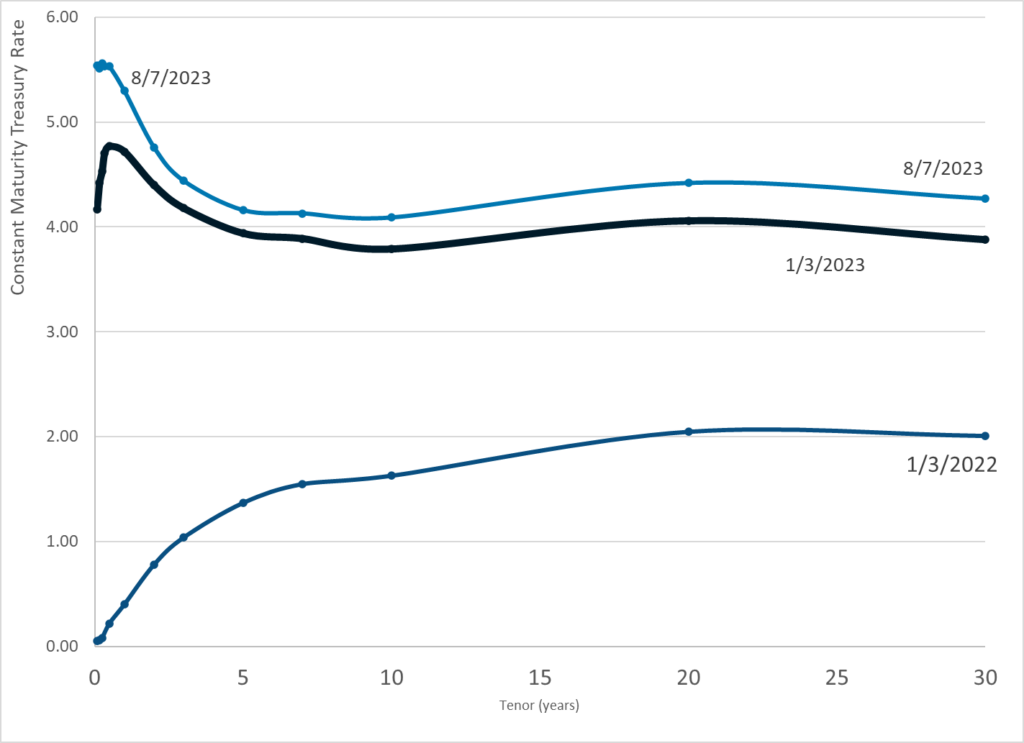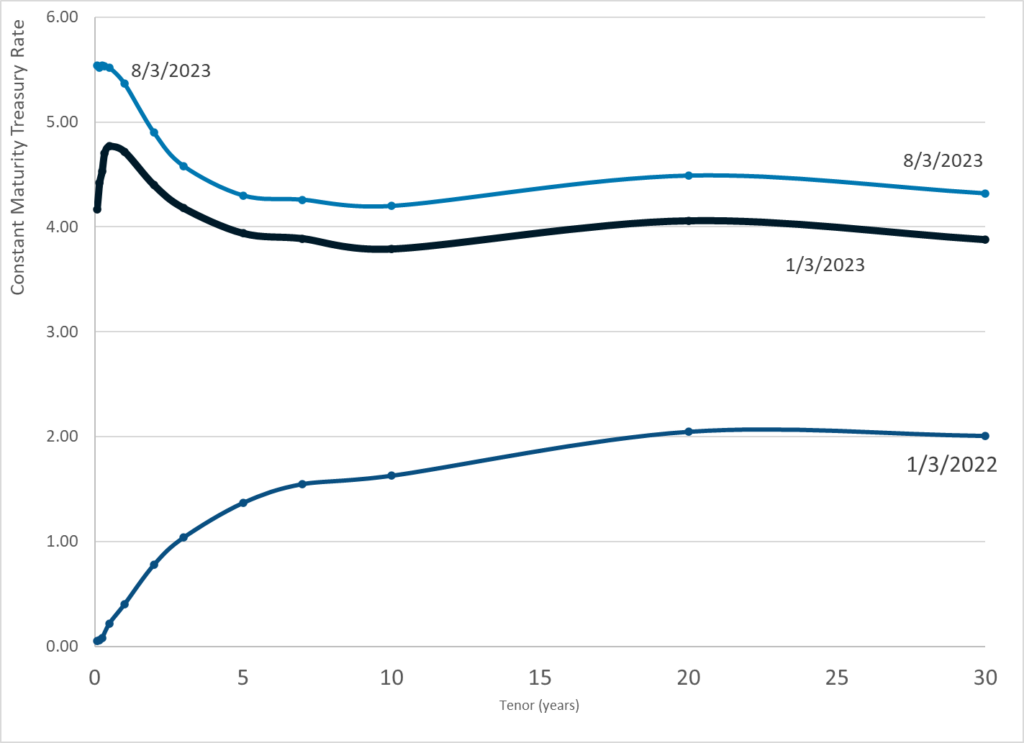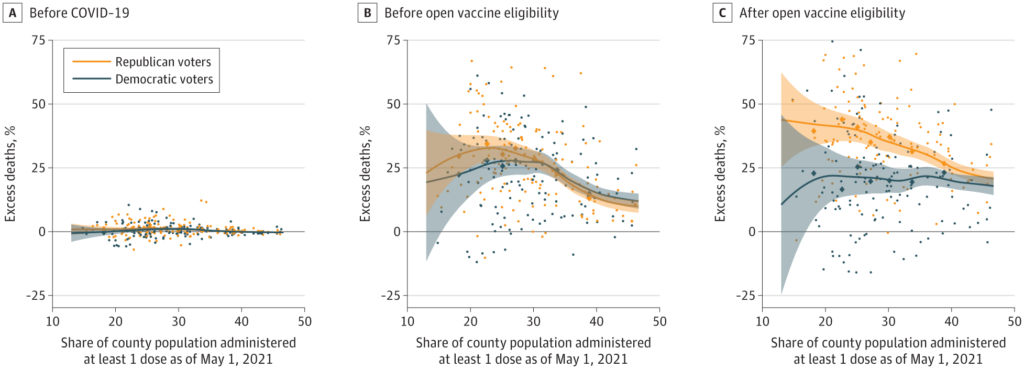Graphic:

Publication Date: 7 Aug 2023
Publication Site: Treasury Dept
All about risk
Graphic:

Publication Date: 7 Aug 2023
Publication Site: Treasury Dept
Graphic:
Publication Date: 4Aug 2023
Publication Site: Treasury Dept
Graphic:

Excerpt:
Franklin, who was a printer, among his other roles, was known for marking his early paper money with images of intricately veined leaves that were nearly impossible for counterfeiters to copy, using a variety of fonts, some available only to him, and intentionally lacing the text with misspellings.
But scientists say Franklin took things a step further to stave off fraudsters. Other distinguishing characteristics of Franklin’s money—the new research revealed through advanced atomic-level imaging methods—were more subtle. He used a unique black ink. His paper glimmered. Blue threads decorated the surface, and finer fibers were woven throughout.
Researchers detailed the innovations in a paper published Monday in the journal Proceedings of the National Academy of Sciences. The findings describe previously unknown methods Franklin developed to safeguard printed money notes against counterfeiting.
Author(s): Jo Craven McGinty
Publication Date: 17 July 2023
Publication Site: WSJ
Graphic:

Excerpt:
Everyone knows, or at least should know, that the “Big 3” rating agencies that rate about 98 percent of all debt all issue trash ratings. Here’s the background on how that happened.
Rating agencies used to get paid by investors on the basis of how well they did at estimating the likelihood of default. The better your ratings, the more sought out your opinions.
In the mid 1970s, the SEC created nationally recognized statistical ratings organizations (NRSROs). Following that idiotic regulation, the rating agencies got paid on the basis of how much debt they rated, not how accurate their ratings were. Fees come from corporations issuing debt, not investors seeking true default risk.
The more stuff you rate AAA, the more business you get from companies who want their debt rated. The new model is ass backward, and why ratings are trash. A genuine fiasco happened with ratings during the Great Financial Crisis with tons of garbage rated AAA went to zero.
There should not be NRSROs. The SEC made matters much worse, except of course for the Big 3 who have a a captured, mandated audience, coupled with massive conflicts of interest.
Author(s): Mike Shedlock
Publication Date: 5 Aug 2023
Publication Site: Mish Talk
Graphic:

Publication Date: 3 Aug 2023
Publication Site: Treasury Department
Graphic:

Publication Date: 2 Aug 2023
Publication Site: Treasury Department
Link: https://jamanetwork.com/journals/jamainternalmedicine/fullarticle/2807617
Graphic:

Excerpt:
Key Points
Question Was political party affiliation a risk factor associated with excess mortality during the COVID-19 pandemic in Florida and Ohio?
Findings In this cohort study evaluating 538 159 deaths in individuals aged 25 years and older in Florida and Ohio between March 2020 and December 2021, excess mortality was significantly higher for Republican voters than Democratic voters after COVID-19 vaccines were available to all adults, but not before. These differences were concentrated in counties with lower vaccination rates, and primarily noted in voters residing in Ohio.
Meaning The differences in excess mortality by political party affiliation after COVID-19 vaccines were available to all adults suggest that differences in vaccination attitudes and reported uptake between Republican and Democratic voters may have been a factor in the severity and trajectory of the pandemic in the US.
Abstract
Importance There is evidence that Republican-leaning counties have had higher COVID-19 death rates than Democratic-leaning counties and similar evidence of an association between political party affiliation and attitudes regarding COVID-19 vaccination; further data on these rates may be useful.
Objective To assess political party affiliation and mortality rates for individuals during the initial 22 months of the COVID-19 pandemic.
Design, Setting, and Participants A cross-sectional comparison of excess mortality between registered Republican and Democratic voters between March 2020 and December 2021 adjusted for age and state of voter registration was conducted. Voter and mortality data from Florida and Ohio in 2017 linked to mortality records for January 1, 2018, to December 31, 2021, were used in data analysis.
Exposures Political party affiliation.
Main Outcomes and Measures Excess weekly deaths during the COVID-19 pandemic adjusted for age, county, party affiliation, and seasonality.
Results Between January 1, 2018, and December 31, 2021, there were 538 159 individuals in Ohio and Florida who died at age 25 years or older in the study sample. The median age at death was 78 years (IQR, 71-89 years). Overall, the excess death rate for Republican voters was 2.8 percentage points, or 15%, higher than the excess death rate for Democratic voters (95% prediction interval [PI], 1.6-3.7 percentage points). After May 1, 2021, when vaccines were available to all adults, the excess death rate gap between Republican and Democratic voters widened from −0.9 percentage point (95% PI, −2.5 to 0.3 percentage points) to 7.7 percentage points (95% PI, 6.0-9.3 percentage points) in the adjusted analysis; the excess death rate among Republican voters was 43% higher than the excess death rate among Democratic voters. The gap in excess death rates between Republican and Democratic voters was larger in counties with lower vaccination rates and was primarily noted in voters residing in Ohio.
Conclusions and Relevance In this cross-sectional study, an association was observed between political party affiliation and excess deaths in Ohio and Florida after COVID-19 vaccines were available to all adults. These findings suggest that differences in vaccination attitudes and reported uptake between Republican and Democratic voters may have been factors in the severity and trajectory of the pandemic in the US.
Author(s): Jacob Wallace, PhD1; Paul Goldsmith-Pinkham, PhD2; Jason L. Schwartz, PhD1
Publication Date: 24 July 2023
Publication Site: JAMA Internal Medicine
Link: https://www.wsj.com/articles/fitch-downgrades-u-s-credit-rating-56c73b89?mod=hp_lead_pos1
Excerpt:
Fitch Ratings downgraded the U.S. government’s credit rating weeks after President Biden and congressional Republicans came to the brink of a historic default, warning about the growing debt burden and political dysfunction in Washington.
The downgrade, the first by a major ratings firm in more than a decade, is evidence that increasingly frequent political skirmishes over the U.S. government’s finances are clouding the outlook for the $25 trillion global market for Treasurys. Fitch’s rating on the U.S. now stands at “AA+”, or one notch below the top “AAA” grade.
….
Few investors believe that Fitch’s downgrade will immediately challenge that role. Still, it is the first time a ratings firm lowered its headline assessment of the U.S. government’s propensity to pay its bills on time since Standard & Poor’s in 2011 lowered its rating one notch below the top grade. That decision followed another tense debt-ceiling standoff in Congress.
Moody’s, the other member of the three big U.S. ratings firms, continues to give the U.S. its strongest assessment.
Fitch said Tuesday that the downgrade reflects an “erosion of governance” in the U.S. relative to other top-tier economies over the last two decades.
“The repeated debt-limit political standoffs and last-minute resolutions have eroded confidence in fiscal management,” Fitch said.
Author(s): Matt Grossman and Andrew Duehren
Publication Date: 1 Aug 2023
Publication Site: WSJ
Excerpt:
Attention #actuaries: with voting underway for the #ifoa Council elections, I share in this short video some thoughts and concerns about the Institute and Faculty of Actuaries. I touch on current problems, what I learned from my time with the Continuous Mortality Investigation and the COVID-19 Actuaries Response Group, and I stumble into the elephant in the room – the recent media coverage of the IFoA (with implications of procedural subterfuge).
Whoever you decide to vote for, please do take the time to engage with the election process, consider what each candidate can contribute to move the profession forwards, and whether you want an active council or a passive council: make your vote count for the sake of your profession.
Author(s): Matthew Edwards
Publication Date: 26 July 2023
Publication Site: LinkedIn